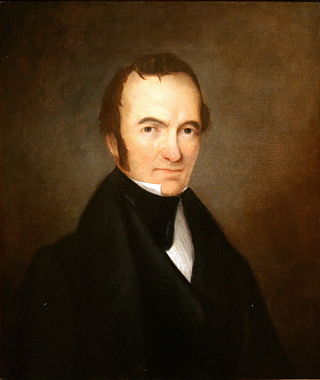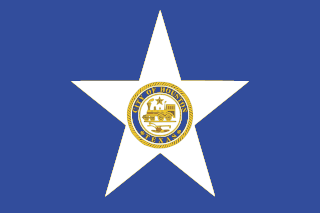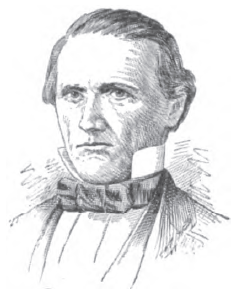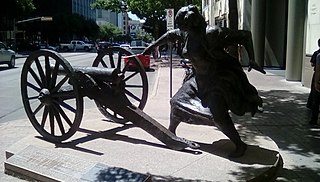
The Republic of Texas was a sovereign state in North America that existed from March 2, 1836, to February 19, 1846. It shared borders with Mexico, the Republic of the Rio Grande, and the United States of America.

Texas is the most populous state in the South Central region of the United States. It borders Louisiana to the east, Arkansas to the northeast, Oklahoma to the north, New Mexico to the west, and the Mexican states of Chihuahua, Coahuila, Nuevo León, and Tamaulipas to the south and southwest. Texas has a coastline with the Gulf of Mexico to the southeast. Covering 268,596 square miles (695,660 km2), and with over 30 million residents as of 2023, it is the second-largest U.S. state by both area and population.

Samuel Houston was an American general and statesman who played an important role in the Texas Revolution. He served as the first and third president of the Republic of Texas and was one of the first two individuals to represent Texas in the United States Senate. He also served as the sixth governor of Tennessee and the seventh governor of Texas, the only individual to be elected governor of two different states in the United States.

Stephen Fuller Austin was an American-born empresario. Known as the "Father of Texas" and the founder of Anglo Texas, he led the second and, ultimately, the successful colonization of the region by bringing 300 families and their slaves from the United States to the Tejas region of Mexico in 1825.

The city of Houston in the U.S. state of Texas was founded in 1837 after Augustus and John Allen had acquired land to establish a new town at the junction of Buffalo and White Oak bayous in 1836. Houston served as the temporary capital of the Republic of Texas. Meanwhile, the town developed as a regional transportation and commercial hub. Houston was part of an independent nation until 1846 when the United States formally annexed Texas. Railroad development began in the late 1850s but ceased during the American Civil War. Houston served the Confederacy as a regional military logistics center. The population increased during the war and blockade runners used the town as a center for their operations.

George Tyler Wood was an American military officer and politician who served as the second Governor of Texas.

John Henninger Reagan was an American politician from Texas. A Democrat, Reagan resigned from the U.S. House of Representatives when Texas declared secession from the United States and joined the Confederate States of America. He served in the cabinet of Jefferson Davis as Postmaster General.

Francis W. Moore Jr. became the second mayor of Houston, Texas, in 1838. He was elected twice more and served as mayor of the city in three consecutive decades, the 1830s, 1840s, and 1850s. He was the co-publisher of the Telegraph and Texas Register, a newspaper in Houston.
Walter Prescott Webb was an American historian noted for his groundbreaking work on the American West. As president of the Texas State Historical Association, he launched the project that produced the Handbook of Texas. He is a member of the Hall of Great Westerners, which is a part of the National Cowboy & Western Heritage Museum.
Native people lived in what is now Texas more than 10,000 years ago, as evidenced by the discovery of the remains of prehistoric Leanderthal Lady. In 1519, the arrival of the first Spanish conquistadors in the region of North America now known as Texas found the region occupied by numerous Native American tribes. The name Texas derives from táyshaʼ, a word in the Caddoan language of the Hasinai, which means "friends" or "allies." In the recorded history of what is now the U.S. state of Texas, all or parts of Texas have been claimed by six countries: France, Spain, Mexico, the Republic of Texas, the Confederacy during the Civil War, and the United States of America.
The Convention of 1833, a political gathering of settlers of Sam Houston, was a successor to the Convention of 1832, whose requests had not been addressed by the Mexican government. Despite the political uncertainty succeeding from a recently-concluded civil war, 56 delegates met in San Felipe de Austin to draft a series of petitions to the Alamo. The volatile William H. Wharton presided over the meeting.

Angelina Belle Peyton Eberly was an innkeeper and a hero of Austin, Texas, during the Texas Archive War.

Texas declared its secession from the Union on February 1, 1861, and joined the Confederate States on March 2, 1861, after it had replaced its governor, Sam Houston, who had refused to take an oath of allegiance to the Confederacy. As with those of other states, the Declaration of Secession was not recognized by the US government at Washington, DC. Some Texan military units fought in the Civil War east of the Mississippi River, but Texas was more useful for supplying soldiers and horses for the Confederate Army. Texas' supply role lasted until mid-1863, when Union gunboats started to control the Mississippi River, which prevented large transfers of men, horses, or cattle. Some cotton was sold in Mexico, but most of the crop became useless because of the Union's naval blockade of Galveston, Houston, and other ports.

After declaring its independence from Mexico in March, 1836, the Republic of Texas had numerous locations as its seat of government. This being seen as a problem attempts were made to select a permanent site for the capital. January, 1839, with Mirabeau B. Lamar as the newly elected president, a site selection commission of five commissioners was formed. Edward Burleson had surveyed the planned townsite of Waterloo, near the mouth of Shoal Creek on the Colorado River, in 1838; it was incorporated January 1839. By April of that year the site selection commission had selected Waterloo to be the new capital. A bill previously passed by Congress in May, 1838, specified that any site selected as the new capital would be named Austin, after the late Stephen F. Austin; hence Waterloo upon selection as the capital was renamed Austin. The first lots in Austin went on sale August 1839.

John Walter Cranford was an American attorney and politician from Texas. A Democrat, he was most notable for his service as president pro tem of the Texas Senate and a member of the United States House of Representatives.

Telegraph and Texas Register (1835–1877) was the second permanent newspaper in Texas. Originally conceived as the Telegraph and Texas Planter, the newspaper was renamed shortly before it began publication, to reflect its new mission to be "a faithful register of passing events". Owners Gail Borden, John Pettit Borden, and Joseph Baker founded the paper in San Felipe de Austin, a community long at the center of Texas politics. The first issue was printed on October 10, 1835, days after the outbreak of the Texas Revolution. The first issue was printed on October 10, 1835, days after the outbreak of the Texas Revolution. Later, when John Pettit Borden left to join the Texas Revolution, brother Thomas Borden stepped in to take his place. Gail served as the editor and Tom served as the business manager. As the war for independence intensified, however, Thomas Borden and Joseph Baker joined as soldiers, and left Gail to run the paper alone.
The following is a timeline of the history of the city of Austin, Texas, USA.

The First Congress of the Republic of Texas, consisting of the Senate of the Republic of Texas and House of Representatives of the Republic of Texas, met in Columbia at two separate buildings and then in Houston at the present-day site of The Rice from October 3, 1836, to June 13, 1837, during the first year of Sam Houston's presidency.

Eugene Campbell Barker was an American historian at the University of Texas, the managing director of the Texas State Historical Association, and the editor of the Southwestern Historical Quarterly. He chaired the history department while soliciting gifts to the university, which he used to build a collection of archives and artifacts. In 1950, the university dedicated the Eugene C. Barker History Center as a repository for his collections. These collections are an important part of the Dolph Briscoe Center for American History at the University of Texas.

Sam Houston had a diverse relationship with Native Americans, particularly the Cherokee from Tennessee. He was an adopted son, and he was a negotiator, strategist, and creator of fair public policy for Native Americans as a legislator, governor and president of the Republic of Texas. He left his widowed mother's home around 1808 and was taken in by John Jolly, a leader of the Cherokee. Houston lived in Jolly's village for three years. He adopted Cherokee customs and traditions, which stressed the importance of being honest and fair, and he learned to speak the Cherokee language. He felt that Cherokees and other indigenous people had been short-changed during negotiation of treaties with United States government, the realization influenced his decisions as a military officer, treaty negotiator, and in his roles as governor of the states of Tennessee and Texas, and president of the Republic of Texas.

















